Report of a Survey Tour to Northern Nigeria
|
tn.jpg) |
tn.jpg) |
tn.jpg) |
The symposium officially began with remarks delivered by the Emir of Zazzau, Alhaji Shehu Idris who represented His Eminence, the Sultan of Sokoto, Alhaji Muhammad Sa’ad Abubakar. U.S. Ambassador, John Campbell, delivered an opening keynote speech, and Professor Shehu Galadanci gave an opening keynote address entitled ‘The Scope and Significance of Arabic Manuscripts in Northern Nigeria’which gave an account of the introduction of Arabic manuscripts into Northern Nigeria, and the subject matter of those manuscripts. The earliest manuscripts presumed to be introduced included (a) copies of the Holy Quran brought from other Muslim countries by merchants, and visiting scholars, teachers, and Jihad leaders; (b) standard primary books dealing with acts of devotion and religious observation laid down by the Sharia; and, (c) poems praising the Prophet and the literary output of scholars treating a wide range of disciplines and themes.
Paper presentations were given by 20 invited speakers (including myself). Dr. Murray Last, Emeritus Professor of Anthropology, University College London and internationally reknowned scholar in the field of the study of Arabic manuscripts in the Northern Nigeria region, presented a paper on “The Book in the Sokoto Caliphate”and the Islamic tradition of learning. Over 200 people, representing libraries, archives, museums, and government agencies gathered to hear the papers and to discuss the issues of preserving Nigeria’s manuscript heritage and making use of digital technologies. Paper topics included the following sub-themes:
•Legal Framework for the Protection of Arabic Manuscripts and
Cultural Property Heritage in Nigeria
•Preserving Africa’s Ancient Written Tradition in the Twenty-first
Century: Aluka’s Partnership with Timbuktu Libraries
•The Preservation of Africana Resources in the Library of Congress: Issues
and Challenges to Building Digital Collections
•Kundi Book Legacy in Pre-Colonial Hausa
•Continuity and Change in the Literary Tradition of the Sokoto Caliphate
•Manuscripts Learnability & Indigenous Knowledge for the Development
of Hausa Ajami in Historical Context
•Major Arabic Manuscripts Authored by Estako Scholars of Edo State and their
Northern Nigerian Connection
•Islamic Literary Traditions and the State of Manuscripts Collections in
Nupe Land
•Arabic Manuscripts Collection, Cataloguing and Preservation: the Sokoto
Experience
•An Overview on the Medicinal Arabic Manuscripts of the Sokoto Calphate
•The State of Arabic Manuscripts in Nigeria
•A Position Paper on Research Activities in the Centre for Islamic Studies,
Usman Danfodio University, Sokoto
•The Linguistic Value of Manuscripts and the Necessity for their Preservation
and Utilization
•Place of Weather & Climate in the Preservation of Scholarly and Literary
Trditions and Manuscripts Heritage
•The Case of Microfilm Collections in the National Archives ofNigeria and
the University of Ibadan Libraries
•The State of the Kano State Archives
Additionally, the conference program showcased an impressive exhibition of Arabic manuscripts from northern Nigerian libraries and cultural repositories, as well as, demonstrations of traditional bookbinding, paper restoration techniques, and Islamic calligraphy.
tn.jpg) |
tn.jpg) |
On the second day, attendees broke up into five small groups to brainstorm on five topics -- scholarship, preservation, cataloging, Ajami-Arabic text, and digitization. I was invited to provide consultation to the digitization working group on digital preservation planning and management issues. Each group consisted of a facilitator, a recorder/reporter, and ten or twelve group members. The groups met in private sessions for ninety minutes. After the discussions, the attendees reconvened, and each then had fifteen minutes to share the results of their discussions.
All the working groups agreed on the following three points: (1) a consortium of member institutions should be established to provide for the care and conservation of Nigeria’s significant and valuable manuscript collection; (2) Arewa House has a role to play as a Secretariat or coordinating institution to mobilize experts and partnerships with libraries, archives, universities, cultural institutions, research centers for Islamic and Legal studies, linkages with libraries and research centers abroad, political networks, and donor funding from agencies such as the Kuwait Foundation, Faisal Foundation, Forkan, Carnegie, Ford, Rockefellers, UNESCO, etc., and (3) a five year rolling plan should be developed outlining preservation and conservation programs and projects, research teams, time lines, and budgets.
Arriving in the city of Abuja, Nigeria’s Federal Capital Territory, I met with United States Ambassador to Nigeria John Campbell, Counselor for Public Affairs Officer, Atim George and U.S. Cultural Attache, Mr. Henry Mendelsohn. During my trip, I met with a number of traditional rulers, government officials, university and educational leaders, as well as scholars from Nigerian universities, research centers, and cultural bureaus. My tour included formal presentations at the Chief Bole Ige Information Technology Information Center and American Corner in Abuja, Nigeria; presentations to the combined faculties of Islamic Studies and History Departments at the Usmanu DanFodio University, Sokoto; and presentations to the combined faculties of Islamic Studies, History, and Library Science at the Ahmadu Bello University (ABU), Zaria. Additionally, at the invitation of Ms. Victoria Okojie, President of the Nigerian Library Association, I made a brief presentation at the annual general business meeting of the West African Library Association (WALA). I also met with Dr. Linus Ikpaahindi, the new Director of the National Library of Nigeria.,
The cultural assets of Nigeria’s Northern Region are amongst the most fascinating in sub-Saharan Africa. I had the opportunity to visit the Tombs of Usman Dan Fodio and his daughter Nana Asma’u, the Emir’s Palace of Sokoto, the Waziri Junaidu History and Culture Bureau, the Uthman Dan Fodio University, the Central Mosque within the walls of the old city of Kano, the Emir’s Palace in Kano, and the National Mosque in Abuja, the new federal capital since 1991.
Context: the Northern Nigerian Environment
From the late 9th through to the 15th century, the area referred to today as ‘Northern Nigeria’has served as a nexus of immense cultural and economic activity. Exchanges of language, commerce, and religious belief and thought established this vast region’s strategic importance throughout the Islamic world. During medieval times, Northern Nigeria had contact with the great African empires of ancient Ghana, Mali, Kanem Borno, and Songhay and with countries of the Mediterranean region and beyond. Islamic influence was firmly established by the end of the 14th century, and Kano was famous not only as a center of Islamic studies but also as an important commercial center of the states and societies in the Western Sudan. The creation of the Sokoto Caliphate in the jihad (holy war) of 1804-8 brought most of the northern region under a single Islamic government. The complexion of Nigeria today continues to be determined by influences originating in the 19th century jihad.
As traders from the traditional centers of Islamic learning, such as the Maghreb and Egypt, developed contact with the people of Sudanic and Sahelian Africa, Hausaland and beyond, important centers of Islamic learning and scholarship emerged. These learning centers not only served to facilitate scholarly exchanges between traveling scholars, but also to cultivate vast numbers of indigenous scholars, who composed manuscript works written in Arabic and in the traditional Arabic script known as A’jami (Hausa, Fulfulde, Kanuri, Nupe and other Western Sudanic languages works in the Arabic script). In conjunction with producing some of West Africa’s most important religious treatises, historiographies, literary and scientific works, these areas were also the home of advanced book arts and crafts, including illumination, binding and calligraphy.
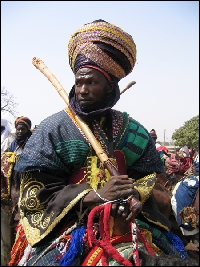 |
Current State of
Arabic Manuscripts in Northern Nigeria: Provenance, Antiquity and Intellectual
Content of Manuscript Collections
Dating as far back as the 11th century, the Arabic manuscript heritage of Northern Nigeria is a vast treasure trove of invaluable source materials on the period of the Islamic revolution in the West Africa sub-region and shows also the contribution of African scholars to Islamic heritage and world civilization. The manuscripts provide a written testimony to the skill of African scientists, in astronomy, mathematics, chemistry, medicine and climatology in the Middle Ages.
In Nigeria’s Northern states, aspects of the historical, social, and economic life of various peoples are documented and preserved in the Arabic language or script. The greater percentage of these documents are in manuscript form. Apart from the personal libraries of scholars and individual families, several collections of Arabic manuscripts of interest to researchers can be found in public libraries and research centers in the North and in the nation at large; as well as, in neighboring countries. These include the following institutions: Arewa House Centre for Documentation and Historical Research, Kaduna; Nigerian National Archives, Kaduna; Library of the Lugard Memorial Hall, Kaduna; Nigerian National Museums and Monuments, Jos; Centre for Arabic Documentation, Institute of African Studies, University of Ibadan; Kenneth Dike Library, University of Ibadan; Bayero University Library, Kano; Kano State History and Culture Bureau, Kano; Library of Aminu School of Islamic Legal Studies, Kano; Borno College of Legal and Islamic Studies, Maiduguri, Centre for Trans-Saharan Studies, University of Maiduguri; Centre for Islamic Studies, Usumanu Danfodiyo University, Sokoto; Sokoto State History Bureau, Sokoto; and the Ahmadu Bello University, Zaria. Arabic manuscripts of the Northern Nigeria region can also be found scattered in repositories in Asian, American and European countries; notably, the Bibliotheque National, Paris, the British Museum, London, the Library of the School of Oriental and African Studies, University of London, and Northwestern University, United States. In a collection development context, it is important to note that many of the Arabic manuscript collections at one institution complement and enrich resources at other institutions.
tn.jpg) |
tn.jpg) |
The Arabic manuscript collections in Nigeria constitute works produced in the principal centers of power and Islamic learning i.e., Borno, Sokoto, Katsina, and Kano. Conceptions of Arabic manuscripts may also be extended to include documents in other languages of Nigeria, such as Hausa, Fulfulde, Kanuri or Yoruba which are written in a version of the Arabic script known as Ajami (or Ajamiyya).
The manuscripts can be classified into three forms; namely, originals (which can either be on parchment, papyrus, or paper), photographic reproductions, and microfilms. Their content contains discourses on various areas of socio-economic, cultural and political interest, including mathematics, chemistry, physics, optics, astronomy, medicine, Islamic sciences, history, geography, the traditions of The Prophet, government legislation and treaties, jurisprudence, logic and philosophy, as well as poetry and literature. Some of the manuscripts, particularly the Quranic ones, are beautifully illustrated or illuminated with different motifs that are, largely, informed by the cultural background of the individual scholars. Intellectual works include those of notable leaders of the 19th century Jihad in the Northern Region of Nigeria, including Sheikh Uthman-Dan-Fodio, his brother, Abdallahi Dan Fodio his son, Sultan Muhammad Bello of Sokoto, and the works of the Nana Asma’U, daughter of Uthman dan Fodio, scholar , poet and scribe. Additionally, there are works of scholars from North Africa, Timbuktu, and Mauritania.
tn.jpg) |
Current Repositories, Main Collections, and Intellectual Access
Islamic intellectuals, clerics, and information professionals estimate that hundreds of thousands of Arabic manuscripts can be found scattered throughout Nigeria’s Northern Region and in other locations in West Africa. This large and important world intellectual resource is, tragically, in great danger of being damaged or even lost forever. The critical nature of the neglect of Nigeria’s Arabic-Islamic intellectual heritage is summed up by Professor Bunmi Alegbeleye, Dean, Faculty of Education, University of Ibadan:
... “Today, most of our cherished documentary resources are either totally destroyed or in extreme jeopardy. Although, there has been a measure of success in the preservation of the built and natural heritage, there has been no parallel development on a national scale for collections of art, history, literature, information and science housed in our museums, galleries, libraries, archives and associated organizations and private collections held by individuals and corporations ...”.
During my visit to Northern Nigeria, I had the opportunity to informally survey the physical condition and present state of some of the Arabic manuscript holdings in the Arewa House Centre for Documentation and Historical Research and in the National Archives in Kaduna. In the Northern city of Sokoto, I surveyed the manuscript collections of the Waziri Junaidu Culture and History Bureau. In Kano, I surveyed Arabic documents in the Kano History and Culture Bureau. Unfortunately, plans to examine manuscript collections of private holders could not take place due to lack of time.
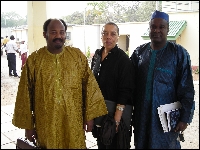 |
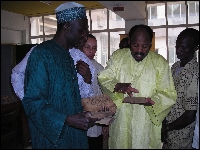 |
Zaria: Arewa House Center for Research and Historical
Documentation, Ahmadu Bello University
In the Arewa House Center for Research and Historical Documentation of the
Ahmadu Bello University, a considerable collection of Arabic manuscripts in
form of correspondences, jurisprudences, history and poetry are housed in the
Center’s archives. Some manuscripts consist of photocopies or photo reproductions
of items from other collections; namely, the University of Ibadan, National
Archives, Kaduna, and the Jos Museum. In addition to important collections
of artefacts of historical and aesthetic interest housed at the Center’s
museum complex, Arewa House serves as the custodian of the official records
of the Sardauna of Sokoto, Sir Ahmadu Bello, the first premier of the Northern
Nigeria region from 1954-1966, a source material uniquely indispensable to
the study of contemporary Nigeria.
Kaduna: Nigerian National Archives
At the Nigerian National Archives of Kaduna, the majority of the holdings are
original Arabic manuscripts (dating back to the 12th century A.D). There
is no form of conventional classification for the various collections; however,
a two-volume handlist containing some 1600+ manuscripts in the National Archives
has been published by the Al-Furqan Islamic Heritage Foundation, London.
An “Authors Index of Arabic Manuscripts, 1959-1973" which lists
some 1200 items, giving title, author, location (province/box/item) and number
of pages is also available. Another major index entitled “A List of
Similar Manuscripts grouped together, vol. I, 1959-1976" consists of
a simple list of titles or best-known names of books and arranged alphabetically.
A estimated 4,380 items are listed. (NOTE: Other significant collections
at the National Archives complex include legal ‘Shari’a court
records of the region (dating from 1918 to 1929 and written in Arabic), handwritten
records of Sir Frederick Lugard who was the Governor-General of Nigeria 1914-1919,
and colonial government official publications).
Kano: State History and Culture Bureau
In the Kano State History and Culture Bureau, a substantial collection of Arabic
manuscripts are held in two large ‘unsecured rooms’without adequate
climate control. Largely uncatalogued, most of the materials lie in piles
on the floor. Holdings include an interesting collection of letters, several
with English summaries, from the private archives of the Wazir of Sokoto
and the Emir’s Palace.
Sokoto: Center for Islamic Studies, University of Sokoto
The established Centres for Islamic Studies in the Usumanu Danfodiyo University,
Sokoto (and also in Bayero University, Kano) have among their main functions,
collecting, classifying and cataloguing the writings of Islamic scholars
of Nigeria from the 17th century. The collection in the Center for Islamic
Studies, University of Sokoto is a mixture of originals, locally-published
versions or reproductions of manuscript copies, and photocopies. The estimated
number of items is some 500+. Both institutions have each produced some kind
of cataloging, however, the methodologies can be improved upon. Currently,
they are stored in envelopes listing author’s name and title (in Arabic),
and placed in envelopes of leather-covered slip cases. The material is cataloged
according to the following scheme: class/box/item. To a large extent the
collection replicates the manuscript collection of the Sokoto State History
Board which consists mainly of the writings of authors of the Sokoto region.
.
Sokoto: Waziri Junaidu History and Culture Bureau
The Arabic manuscript collection of the Waziri Junaidu History
and Culture Bureau in Sokoto numbers is an extremely rich resource of
more than 1,000 originals items. The manuscripts are kept in envelopes,
marked on the outside with author and title, in Arabic, and reference
number. The envelopes are kept in leather-covered slip cases. There is
a basic list of holdings which includes author/ title/ remarks. All manuscripts
are numbered and are generally in good condition. The collections consists
mainly of the writings of authors of the Sokoto region.
Ibadan: Kenneth Dike Library and the Centre for Arabic Documentation,
Institute of African Studies, Ibadan University
The Arabic manuscript collections of Sokoto were collected from individual
scholars from Sokoto, Jos, Borno, Ibadan, Oyo, Iwo, Ujebu-Ode, Lagos, Agbede
and Auchi. In addition, some were collected from institutional libraries in
the Northern Nigeria region and from the Bibliotheque Nationale, Paris, and
the Bibliotheque de l‘Institut de France, Paris. At present, many of
the manuscripts are at advanced stages of deterioration. In its efforts to
disseminate information on the manuscripts, The Ibadan Centre for Arabic Documentation
established a Research Bulletin in 1965 in which they give annotated descriptions
of the materials collected. The last issue of the Bulletin appeared in 1980/82.
In addition, a catalogue has been compiled which provides a listing of authors,
titles, numbers, and sizes of folios of the originals, arranged according to
accession number. It is important to point out that due to lack of modern preservation
techniques, the Ibadan University Library Collection of more than 1000 titles
of Arabic manuscripts on microfilm are completely damaged and irretrievable.
Kano: Bayero University Library
During the 1970s, a considerable collection of Arabic manuscripts, mainly of
a literary nature, were assembled in the Department of History. Manuscripts
were borrowed from their owners and photocpied and the originals return.
This collection was subsequently transferred to the University Library, where
they are currently housed in a special documents collection together with
other photocopies Arabic manuscripts obtained since then. In the early 1980s,
a six-volume catalog, which includes abtracts or summaries of some of the
items was prepared. The catalog is in Arabic.
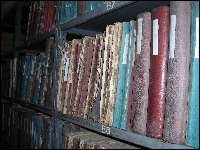 |
 |
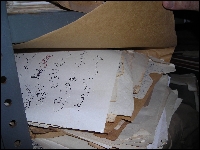 |
Generally speaking,I found the Arabic manuscript collections in Northern Nigeria to be covered with thick harmattan dust, mold, moisture, and damaged by insects very badly. Frayed or ragged pages, water and coffee stained pages, and damaged bindings were also observed. A few manuscripts have been damaged by attempts at ‘first aid’repair. For example, several manuscript copies have been wrapped in protective paper covers, but the covers have been attached to them by adhesive tape or staples. In addition, many documents have been laminated in plastic. There have also been attempts to restore leather bindings by the traditional method of using thread to sew them.
The collections are a mixture of originals and photocopies of varying degrees of legibility. Most of the items are in Arabic, but a few are in Hausa, Nupe, or Fulfulde. In most cases the present storage conditions of the documents are quite unsatisfactory. The manuscripts are kept in wooden or metal trunks, and often they are exposed to extreme light, heat, and humidity exposure. No equipment is available to measure temperature and relative humidity. No air conditioning units are available, and fans generally do not run due to erratic electricity supplies.
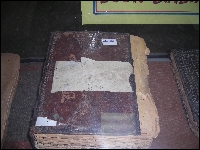 |
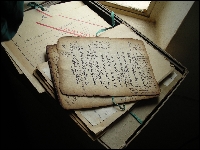 |
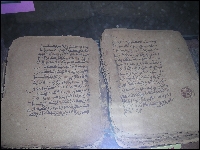 |
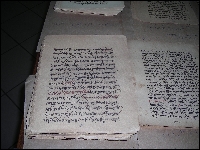 |
tn.jpg) |
At present, the libraries and research institutes in Northern Nigeria
which house Arabic manuscript collections lack the human resource and
technical expertise capacities, as well as financial resources, to manage
and preserve these collections with any degree of efficiency. The brittle
condition of the manuscripts, the termites, insects, weather, and the
piracy and selling of these treasures poses a serious threat to the future
of these invaluable collections. ‘Unless a rescue operation is
taken in the immediate future, many of these priceless manuscripts will
be lost’. An exhaustive inventory is urgently required to identify
endangered materials and to target those materials most in need of preservation
treatment.
It is important to note that a number of scholars and research workers
both within Nigeria and outside have done a great deal of work in collecting
and documenting these Arabic manuscript collections. Additionally, Nigerian
governments at both state and federal levels have made their contributions
to the collections and cataloguing of these documents at national archives
and research centers. In the 1960s there were efforts in Nigeria to collect,
classify and catalogue both Arabic and non-Arabic manuscripts by some
institutions such as the Centre for Arabic Documentation, Institute of
African Studies, University of Ibadan, the Northern History Research
Scheme, Ahmadu Bello University, the Centre for the Study of Nigerian
Languages, Bayero University, Kano, National Archives, Kaduna, National
Museum, Jos., etc. Similarly, in the 1970s, other institutions such as
the Centre for Islamic Studies, Usumanu Danfodiyo University, Sokoto,
Waziri Junaidu Bureau of History and Culture, Sokoto, followed suit and
established collections. Besides these are private libraries such as
Waziri Junaidu’s library, the Gidan Uban Doma library, and the
Abdulkadir b. Mustafa Salame library in Sokoto State.
The fruition of these efforts produced a number of scholarly works which are now used as reference tools in many research centers. The most comprehensive reference source produced is the second volume of Arabic Literature of Africa, compiled by John Hunwick, Hammidu Bobboyi, et. al. Its main purpose is to provide “a bio-bibliographical account of the Arabic literature of Saharan and sub-Saharan Africa”.
Existing translations and analysis of Arabic manuscripts in Nigeria include the studies of H.I. Olagunju (1986), M.G. Hasan (1986), A.F. Ahmed (1983), and the work of Umar Faruk Malumfashi (1989). Studies have also been carried out by contemporary scholars of Islam, both within and outside Nigeria, in dissertations, theses and journal articles.
Observations and Recommendations
The priceless Arabic manuscript collections in the Northern Nigeria region represent one of the most important sources of documentary heritage of the African Islamic world. The manuscripts, particularly those generated by Nigeria’s indigenous scholars, greatly aid the ability to understand local, indigenous knowledge systems and the dynamics of intellectual discourse in the spheres of religion, politics, economics and culture in the West Africa sub-region from earliest times to the present day.
Despite the historical significance of the Arabic manuscript collections in Northern Nigeria, they have been largely neglected. Limited attention is paid to the fact that these valuable manuscript holdings are important cultural property requiring appropriate management, preservation, and conservation measures. At the governmental level, there is an immediate need to strengthen the country’s laws and regulations to facilitate the protection of its intellectual and cultural heritage.
Due to a variety of competing economic, social and political priorities,
libraries and archival repositories in Nigeria face exceptional challenges
in implementing preservation and conservation programs. There seems to
be a general lack of awareness and understanding of the critical need
for protecting the integrity of Nigeria’s Arabic manuscript collections
and of preservation and cultural property issues, both in the public
and private sectors. The convening of the international conference on
Preserving Nigeria’s Scholarly and Literary Traditions and Arabic
Manuscript Heritage at Arewa House from March 7th to 8th, 2007 provided
an important opportunity for major stakeholders to get together under
one umbrella and to begin formulating plans for future preservation action
and programs to improve national capabilities to address the preservation
needs of Nigeria’s rich and vast Arabic-Islamic manuscript heritage.
Based upon my onsite visits, my preliminary assessment of the present state
and conditions affecting the Arabic manuscript collections in the Northern
Nigeria Region are that current arrangements are totally inadequate for their
safekeeping. Suitable protective measures and urgent preservation action is
needed, particularly special care and archival quality housing. Environmental
conditions (including the lack of air conditioners, dehumidifiers, and security
and fire protection systems) and the lack of conservation treatment supplies
and equipment pose a great threat to these rare and valuable primary source
materials.
There is an immediate need that grants be sourced internationally and locally to engage a conservator, preservation librarian, archivist, or other appropriate consultant to conduct a full preservation/conservation assessment; and also, to help draft a long-range plan to ensure that the manuscript collections are available and accessible for generations to come. Specific professional advice is needed to address the following preservation issues:
•collection disaster preparedness and response plans;
•environmental monitoring of collection housing and storage areas;
•security protection;
•care and handling of manuscripts
•reformatting of brittle materials (including digital reproduction);
•assessing conservation treatment needs of selected ‘high priority’items
in a collection.
Major donors, from both private and public sectors, that might support Nigeria’s preservation initiatives include the following organizations: Carnegie, Faisal Foundation, Ford, Forkan, Kuwait Foundation, Rockefeller, UNESCO, petroleum companies, etc.
Support is needed to send staff members who work with manuscript collections to workshops, training courses, and meetings that focus on basic preservation conservation techniques (including the care of collections) and the development of preservation programs
Support is needed to facilitate the construction of a state-of-the art working collections conservation laboratory devoted to conservation care and treatment.
Nigeria’s Arabic manuscript collections are scattered all over the country in libraries, research centers, national archives, privately owned libraries and with individuals. Few people have access to them. At present, there is insufficient knowledge on the actual numbers of manuscripts, where they are, what the intellectual content of the manuscripts are, who their authors are, and under what circumstances they were written. Projects that seek to catalog, index, arrange and describe the various collections for research, education, or public programming are essential.
There is a very large number of valuable Arabic manuscripts in various designed centers in different parts of the country; however, this is only a meager percentage of those that are available for collection. More efforts are needed to collect the manuscripts and save them from the risk of destruction or loss.
Almost all of the cultural and research institutions in Nigeria which
house Arabic-Islamic manuscript collections lack the financial resources
to function effectively; and also, lack the human resources and technical
expertise to manage and utilize these manuscripts with any degree of
efficiency. As previously mentioned, it is not unusual to find manuscript
collections
housed in dust laden rooms, kept in wooden or metal trunks or closets or which
are hardly accessible; or in unsecure places where they can easily be stolen
or places that not have adequate protection against fire and other hazards.
They are generally exposed to excessive light and humidity, and to termites
and other pests.
There is a need to develop workshops for local scholars, Imams, and people involved with manuscripts to sensitize them to the importance of preserving these rare, unique and fragile documents and promoting increased access and use.
In terms of researching the contents of Northern Nigeria’s Arabic manuscripts exceptional progress has been made and the works have been studied by Arabic and Islamic scholars and historians in Nigerian Universities at Ibadan, Kano, Ilorin, Sokoto, Jos, Maidugur, Zaria and Lagos. Many of the manuscripts have also been studied in Britain, France, Germany, Egypt, Saudi Arabic and Morocco. It is important to note that a comprehensive survey is still needed to update our knowledge on the state of Arabic-Islamic manuscript collections in Nigeria. The non-availability of an up-to-date catalogue of Arabic manuscripts in each of the various locations in Nigeria has caused them to be inaccessible. Projects that seek to catalog, index, arrange and describe the various collections for research, education, or public programming are essential.
It is the current policy of the Nigerian government to implement strategic project activities aimed at establishing a coordinated program for the development of a national information infrastructure, at national, state, and local levels. In this context, several Nigerian institutions have some existing information technology infrastructure and digital technical capacity, either in terms of trained IT/ICT staff or in terms of some basic equipment such as computers, servers, scanners, etc. Institutions that stand out include the Ahmadu Bello University, Zaria, Bayero University, Kano, Usman dan Fodio University, Sokoto, the Centre for Information Technology and Development (CITAD), Kano, and the University of Ibadan, Ibadan. Additionally, the. Nigerian National Universities Commission is developing a National Virtual (Digital) Library Project for universities and other institutions of higher education.
At present, no one institution in Nigeria appears to have the ICT, institutional, and necessary technical skills capacity to manage and make digital initiatives fully operational at this time. Professional expertise is needed to raise the level of awareness and expertise of digital preservation issues. Professional expertise is needed to raise the level of awareness and expertise of digital preservation issues.
The state of the Nigerian National Archival institution in Kaduna is in critically poor condition. Existing constraints of the institution include peeling pain, dust, weak or not enough shelving, defunct equipment and facilities (not a single microfilm nor xerox machine was working), air conditioners have completely broken down, and there is an acute shortage of properly trained staff. In addition, there is little or no budgetary support to cater for its operational activities.
There is a need to reflect critically on the role of the archival centers in Nigeria given that they are the national repository libraries legally responsible for the preservation and management of the nation’s cultural heritage.
Given the resource requirements and challenges of digital preservation, mechanisms that link into a collaborative or consortium partnership of all the various institutions in Nigeria that manage Arabic manuscript collections should be explored.
Public and private sector donor support is a critical priority for a long-term sustainable institutional preservation program (including a digital technology infrastructure). Potential funders that might support Nigeria’s preservation initiatives include the Carnegie Foundation, the Faisal Foundation, the Ford Foundation, the Forkan Foundation, the Kuwait Foundation, the Rockefeller Foundation, and UNESCO.
Arif, Aida S., and Ahmad M. Abu-Hakima. Descriptive catalogue of Arabic manuscripts in Nigeria in the Jos Museum and Lugard Hall Library. Kaduna. London, Luza, 1965. 216 p.
Ati, Ojoingu Friday. “Place of Weather and Climate in the Preservation of Scholarly and Literary Traditions and Manuscript Heritage”. International Conference on Preserving Nigeria’s Scholarly and Literary Traditions and Arabic Manuscript Heritage. Arewa House, Ahmadu Bello University, Kaduna, Nigeria, March 7th-8th, 2007.
Bivar, A. D. H. "The Arabic Calligraphy of Nigeria." African Language Review, 7 , 1968: 3-15.
___ “Arabic documents of Northern Nigeria.: Bulletin of the School of Oriental and Africa Studies, 22, pt.2, 1959: 324-349. illus.
___ and M. Hiskett. "The Arabic Literature of Nigeria to 1804: A Provisional Account." Bulletin of the School of Oriental and African Studies 25, 1962: 104-48.
Brockelmann, Carl. Geschichte der arabischen Litteratur. 2. Den supplemenbanden angrepasste aufl. Leiden, E.J. Brill, 1943, 2 v.
____ Tarikh al-Adab al-‘Arabi [History of Arabic Literature] Transl. By ‘Abd al-Halim al-Najjar. Cairo, Dar al-Ma’arif, 1962.
Freeman-Grenville, G.S. P. “Summary of a report on a conference on Arabic documents, held at the University of Ghana, 26th and 27th February, 1965". In Ibadan, Nigeria. University. Centre of Arabic Documentation. Research Bulletin, v. 2, July 1965: 8-39.
Hunwick, John O., Roman Leomeier, Hamidu Bobboyi, Razaq Abu Bakre. Arabic Literature of Africa. Volume 2: The Writings of Central Sudanic Africa. Leiden: Brill, 1995.
____ Arabic Literature of Arabic: Project and Publication. Northwestern University Program of African Studies: Working Paper Series, 2005. 54 p.
____ Arabic Literature of Arabic: a progress report. Sudanic Africa, 6, 1995: 170-182.
Jimoh, Ismaheel A. “The State of Arabic Manuscripts in Nigeria”.
International Conference on Preserving Nigeria’s Scholarly and
Literary Traditions and Arabic Manuscript Heritage. Arewa House, Ahmadu
Bello University, Kaduna, Nigeria, March 7th-8th, 2007.
Kensdale, W.E.N. “The Arabic manuscript collection of the library of
the University College of Ibadan, Nigeria”. WA LA News, 2, June 1955:
21-22.
____ A catalogue of the Arabic manuscripts preserved in the University Library.
Ibadan, Nigeria. Ibadan University Library, 1955-1958. 3 v.
____”Field notes on the Arabic literature of the Western Sudan”. Royal Asiatic Society. Journal, 1955, pt. 3/4: 162-168; 1956, pt.1/2: 78-80; 1958, pt. 1/2: 53-57.
Last, D. Murray. “Arabic manuscripts in the National Archives, Kaduna”. Ibadan, Nigeria. University. Centre of Arabic Documentation. Research Bulletin, 2, July 1966: 1-10.
____. "Arabic Source Material and Historiography in Sokoto to 1864: An Outline". Research Bulletin [Centre of Arabic Documentation] 1.2 (1965): 3-19.
___ . "Arabic Source Material and Historiography in Sokoto since 1864: An Outline". Research Bulletin [Centre of Arabic Documentation] 1.3 (1965): 1-7.
____”National Archives Kaduna: manuscripts of West African auathorship”. Ibadan, Nigeria. University. Centre of Arabic Documentation. Research Bulletin, 3, January 1967: 1-15.
____”Northern Nigeria Manuscript Books in Ahmadu Bello University: a report”. JHSN, 8, July 1965: 4-7.
Mahmud, Khalil. “The Arabic collection of Ibadan University Library”.
Libri, 14, 2, 1964: 97-107
____ "The Arabic Literary Tradition in Nigeria." Nigeria Magazine
145 (1983): 37-54.
Muhammad, Baba Yunus. Handlists of Islamic Manuscripts: Nigeria, Section 1: The Nigerian National Archives, Kaduna State. Edited and annotated by John Hunwick. London, Al Furqan Heritge Foundation, 1995, 243 pp.
Northern History Research Scheme (Project). First interim report. Zaria, 1966, 55 p.
Sifawa, Abdullahi. “Arabic Manuscript Collection, Cataloguing and Preservation: the Sokoto Experience”. International Conference on Preserving Nigeria’s Scholarly and Literary Traditions and Arabic Manuscript Heritage. Arewa House, Ahmadu Bello University, Kaduna, Nigeria, March 7th-8th, 2007.
Umar, Muhammad A. “Legal Framework for the Protection of Arabic Manuscripts and Cultural Property Heritage in Nigeria”. International Conference on Preserving Nigeria’s Scholarly and Literary Traditions and Arabic Manuscript Heritage. Arewa House, Ahmadu Bello University, Kaduna, Nigeria, March 7th-8th, 2007.
Usman, M.T. “Continuity and Change in the Literary Tradition of
the Sokoto Caliphate”. International Conference on Preserving Nigeria’s
Scholarly and Literary Traditions and Arabic Manuscript Heritage. Arewa
House, Ahmadu Bello University, Kaduna, Nigeria, March 7th-8th, 2007.
Vajda, Georges. Index general des manuscrits arabes musulmans de la Bibliotheque
nationale de Paris. Paris, Editions du Centre national de la recherche scientifique,
1953. 743 p.
Whitting, C.E. J. “The unprinted indigenous literature of Northern Nigeria”. Royal Asiatic Society. Journal. Pt.1/2, 1943: p. 23-26.
World Survey of Islamic Manuscripts Volume II. Edited by Geoffrey Roper. Al-Furqan Islamic Heritage Foundation. London, 1993. 724 p.
| The
Library of Congress >> Especially
for Researchers >> Research
Centers April 2, 2008 |
Contact
Us: Ask a Librarian |